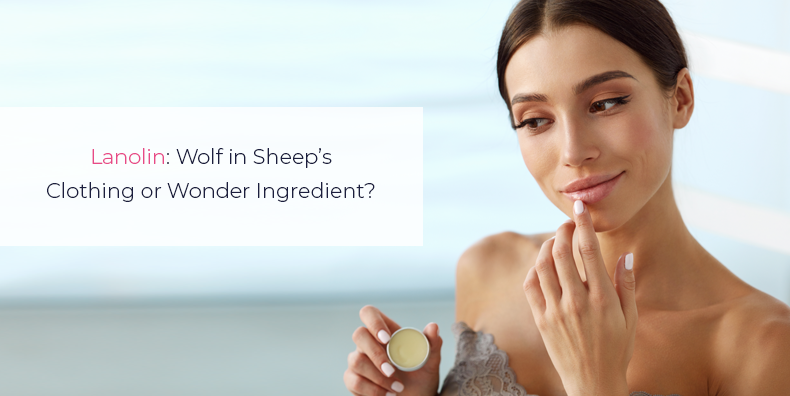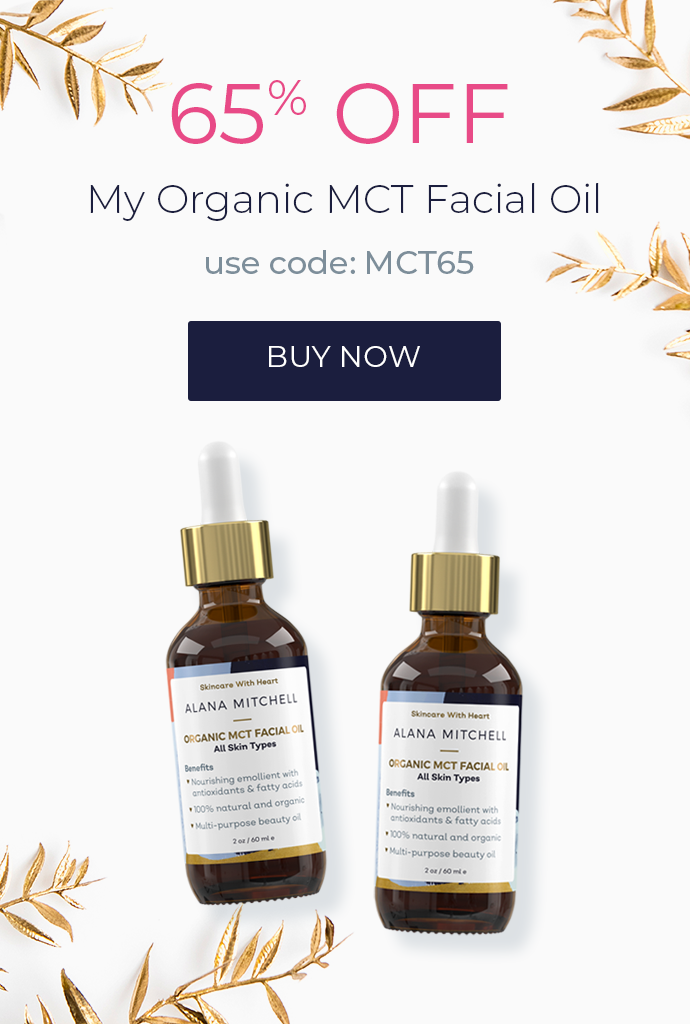What Should You Be Using In Your Skin Care Routine?
Take my quiz and get personalized recommendations from a
licensed esthetician!
Should You Be Worried About Using Lanolin in Skincare Products?
Lanolin has a long history of use in skincare.

And, with that long history come lots of questions!
It’s a fantastic emollient that can help lock moisture into your skin, but as with all things manufactured or processed today, you run into a few issues when deciding whether or not to use it.
With the increasing demand for more safe and natural skincare options, I wanted to address this ingredient that many consider to be “iffy.”
First, let me give you the short and skinny on the questions I hear the most, and then we’ll dive more deeply into the ins and outs of using lanolin on your skin.

What Is Lanolin?
It’s the oil produced by the skin of sheep.
Just as our own sebaceous glands in the skin produce natural oils, so do sheeps’ glands.
And seeing as sheep are covered in wool, lanolin is critical to keeping that wool and the sheep’s skin conditioned properly.
It’s similar to the sebum produced in our own skin, but with a bit of a different composition.
Is Lanolin Safe to Use?
A lot of my clients have asked me if lanolin is baaad for their skin (sheep joke!).
In short, yes, if you’re not allergic to wool and/or wool alcohols, and it’s processed safely. (See more on this below.)
It turns out, components of wool are a pretty common allergen.
Are Sheep Harmed?
I’m not a sheep expert, but this is what I understand from an ingredients perspective…
Lanolin is extracted from sheared wool before it’s made into yarns and fabrics.
So in that way, it doesn’t hurt sheep a bit.
From a vegan perspective, of course, it’s not that simple. And I’ll get into that more below.
Is Lanolin Used In Many Products?
Yes!

Is Lanolin Comedogenic?
Comedogenic simply means pore-clogging.
Generally, what’s comedogenic to your skin may not be to mine, and vice versa.
Every substance will react with your unique skin chemistry, which ultimately determines how likely it will be to clog your pores.
My short answer to this question, therefore, is maybe.
Sebum and other fatty substances definitely contribute to pore clogging under certain circumstances.
If the environment is right – on skin that isn’t properly exfoliated, for instance – lanolin and other oils can clog pores more quickly than less fatty substances.
But on healthy, well-maintained skin – cleansed regularly without stripping away natural oils, exfoliated occasionally, moisturized properly – lanolin generally won’t cause problems with pores.
Remember that lanolin comes in many versions.
The two most likely versions to consistently clog pores regardless of your skin type: acetylated lanolin and acetylated lanolin alcohol.

History of Lanolin
As grazing animals, sheep live most of their domesticated lives out in the open.
Think of lanolin, or wool fat, as sunscreen and wind gear all rolled into one.
It protects sheep from constant exposure to the elements.
The idea of using it for protection on our own skin has been around since the days of the Ancient Greeks.
By the early 1900’s, “wool wax” was a common ingredient in homeopathic skin treatments.
The common practice at the time was to extract the wax from sheared wool manually by boiling the wool and skimming the fat/wax.
When the German, Otto Braun, invented a new process for spinning the wool by machine to extract the wax, the term “lanolin” was first used.
The resulting product was considered to be a purified version of the old wool wax.
Pharmacists of the time began using this purified lanolin in healing salves.
For the next 50-60 years, lanolin was widely known for its scientifically-proven emollient properties and one of the more common ingredients in mass-produced skin treatments and products (both pharmaceutical and non-pharmaceutical).
Sometime around the late 60’s, however, the story of lanolin took a turn for the worse.
At that time, allergic reactions to the lanolin in products became more and more prevalent, and the safety of its use slowly came into question.
It’s now known that this was probably due to pesticide use in agriculture, but more on that below.
Fast forward to today: Purification processes for lanolin have advanced, but there are many grades of the ingredient on the market, so the allergy issue hasn’t been addressed across the board.
Organic agricultural practices address the problem of pesticide contamination, and the higher-grade products are considered the safest.

How Is Lanolin Used in Skincare?
It locks moisture into the skin and prevents it from evaporating while at the same time providing a richly protective environment for skin cells.
If you want to get science-y about it (you know I do!), the substance is a long-chain waxy ester containing lipids.
While it comes in two forms – lanolin and lanolin alcohol – the first version is the one used in cosmetics and skincare products the most.
That version has a high fat content, and your skin loves fat!
That fatty version can help maintain the water content of your skin, keeping skin plump and preventing evaporation, especially in dry environments.
For many years, lanolin was used in everything skin and beauty related.

Pure lanolin creams are also widely used on cracked and calloused areas of skin (like heels) to soften the layers before using an exfoliating tool to remove dead skin layers.
Skincare Benefits
Lanolin first benefits the skin by acting as a natural emollient as I’ve mentioned.
It does this by forming an oily barrier in the top layer of skin that keeps moisture from escaping.
But it doesn’t stop there. It also contains vitamin D which is vital to maintaining the well-being and health of your skin.
In fact, medical research shows that a deficiency of vitamin D can have devastating effects on the skin.
Since vitamin D is fat-soluble, the fat-rich lanolin is particularly good at delivering its important components to the skin where it can do its job of defending the skin against diseases like skin cancer.
Vitamin D, overall, provides protection for the skin by boosting the skin’s immune response and both forming and maintaining the skin barrier.
In that way, it also helps in wound healing.
In some cases, I’ve seen skin issues that were eventually linked to vitamin D deficiency.
It turns out that vitamin D deficiency is considered an epidemic globally right now.
It’s a good idea to check that you’re getting the recommended daily allowance in your diet (600 IU for healthy adults)...but also recognize that the skin is a source of the vitamin for the body.
Lanolin contains one critical type of vitamin D – vitamin D-3.
Like so many factors, the skin’s ability to synthesize D-3 declines as we age, and D-3 provides protection for the body against everything from colon cancer and breast cancer to high blood pressure.
For the skin itself, vitamin D-3 is necessary to promote skin cell growth and repair and support the skin’s immune response while combatting free radicals.

Skincare Drawbacks
So we’ve covered the benefits of this ingredient, but what about the concerns?
For the most part, all the drawbacks to using lanolin on your skin relate to allergies.
Besides the age-old problem of pesticide use that contributed to lanolin and wool-product allergies, the problem of overexposure is thought to be a contributor as well.
For so many years, lanolin was in everything.
Constant exposure to a substance can sensitize a person to that substance, and that may have happened with lanolin in some cases.
The process of sensitization explains why an allergy to a skincare product can suddenly show up seemingly out of nowhere.
Repeated exposure to the substance can finally result in reaching a threshold after which the skin just can’t tolerate the substance any longer without an immune response.
That immune response results in allergic contact dermatitis or ACD.
Some allergic responses occur as a result of impurities and chemicals present in lanolin from pesticides, while other responses occur as a result of this overexposure.
Because of this double possibility for an immune response caused by lanolin and other wool products, versions of wool fat and wool alcohol often show up in basic patch testing performed by doctors and allergists.
Does the very thought of pulling on a wool sweater over bare skin make you itchy?
It’s possible your skin is sensitized to lanolin or you have a contact allergy to the substance.
Statistically speaking though, it’s more likely just a result of sensitive skin.
Lanolin Alternatives
Clearly, there are at least two cases where you may be looking for an alternative to lanolin despite its many benefits to the skin.
- You’re allergic or suspect you may be.
- You’re vegan or object to the overall treatment of animals in the skincare industry and the impact to the environment.
In either case, it’s okay, you have lots of alternatives!
Look for fatty-acid containing ingredients that are rich in antioxidants for the same emollient effects and the same helpful impact on the skin’s immunity and barrier function.
Here are the alternatives to lanolin to consider that will have the lowest impact on the environment.
Virgin Coconut Oil
All the hype around coconut oil is actually well-deserved.
It’s a natural antioxidant as well as antifungal.
It has a similar fatty component to lanolin as coconut oil is mainly composed of saturated fats but also contains vitamin E and essential amino acids.
Overall, you won’t go wrong with coconut oil in place of lanolin and you’ll still lock in the moisture.
I also recommend that you give MCT oil a try!
Organic Olive Oil
Organic olive oil is similar in composition to coconut oil with some of the same benefits.
It’s also high in vitamin E, antioxidants, and essential fatty acids.
It’s proven to help reduce the effects of photo-aging and sun damage.
Olive oil has a special ingredient called squalene, which helps your skin hold in moisture.
Like components of lanolin, squalene contains some of the same components found in human sebum.
To avoid the potential for harmful additives and preservative, select products that use organic olive oil.
You all know I’m a big fan!
Hyaluronic acid doesn’t contain animal products.
Even though it’s chemically very different from lanolin, it actually provides many of the same benefits in a different way for your skin.
It has an amazing capacity to retain moisture in your skin and is a naturally occurring component in the body which declines as we age.
What does it do?
It carries moisture into your skin, protects it, and it’s one of the keys to unlocking the effects of aging.
Final Thoughts
While we can all agree that lanolin brings some amazing benefits to the table, it’s still not for everyone.
Reasons to use it include its unique and natural ability to protect the skin from the elements, lock in moisture, and deliver the critical - and often lacking - vitamin D-3.
Its chemical components make it a great ally for the skin in preventing dryness, cracking, and even certain skin conditions and diseases.
On the other hand, reasons not to use it include the potential for an allergic reaction, overexposure which could eventually lead to an immune response, or your beliefs about animal products.
All very valid.
At the end of the day, you know your skin, beauties, and I aim to gather up the best information I can for you here so that you can make your best decision on what products and ingredients suit you best.
Love it or hate it? Wondering if you might be sensitive to it? Share in the comments how you feel about using lanolin on your skin and any results you’ve had!
Top Brands
New Brands

Recent Posts

Are You Taking the Right Steps to Care for Your Skin?
Take the Quiz
Skincare Secrets!
10-step guide for healthy, beautiful skin after kids.
100% privacy. I will never spam you!















